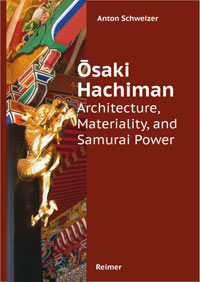
|
|
|
Große Titelansicht | Presse-Infos
Text in englischer Sprache ISBN 978-3-496-01541-3 79,00 € [D] |
Anton Schweizer |
Ôsaki Hachiman
Architecture, Materiality, and Samurai Power in Seventeenth-Century Japan
Sofort lieferbar. Erschienen August 2016
Monumentale Schreinarchitektur im Japan der Frühen Neuzeit 
Ôsaki Hachiman (1607), located in Sendai, Japan, is one of only a handful of surviving buildings from the Momoyama period (1568–1615). The shrine is a rare example of “lacquered architecture”—an architectural type characterized by a shiny, black coat made of refined tree sap and evocative of transitory splendor and cyclical renewal. The shrine’s sponsor, the warlord Date Masamune, was one of the last independent feudal lords of his time and remains famous for dispatching diplomatic missions to Mexico, Spain, and Rome. Although his ambitions to become a ruler of Northern Japan were frustrated, his shrine stands as a lasting testament to the political struggles he faced, his global aspirations, and the cultural cloak by which he sought to advance these objectives.
Der Ôsaki Hachiman, errichtet 1607, ist ein reich ausgestatteter Schrein im nordjapanischen Sendai. Das Gebäude drückt Vergänglichkeitsvorstellungen aus, aber steht auch für hauptstädtische Kultur und politische Legitimation – und ist ein spektakuläres Beispiel lackierter Architektur, das hier erstmalig systematisch erforscht wird.
Der Shinto-Schrein Ôsaki Hachiman ist eines der wenigen in Gänze erhaltenen Bauwerke der Momoyama-Zeit (1568–1615). Mit der Errichtung des Schreins verfolgte der Provinzfürst Date Masamune ehrgeizige politische Ziele. Anton Schweizer hat das Gebäude erstmals umfassend erforscht. Er erläutert Materialität und Farbigkeit sowie den vergänglichen Charakter dieser besonderen Form der Architekturdekoration, die eng mit Vorstellungen von zyklischem Werden und Vergehen verknüpft ist. So wird deutlich, dass der Schrein eine wichtige Rolle im Shintô-Glaubenssystem spielt und gleichzeitig Ausdruck temporärer Prachtentfaltung ist.
Der Autor: Anton Schweizer lehrt an der Tulane University in New Orleans/USA. Promotion zur Kunstgeschichte Ostasiens in Heidelberg. Forschungsinteressen: Material und Raum in Kunst und Architektur Japans, Selbstdarstellung sozialer Gruppen, Exportkunst, Kulturtransfer.
Deeply researched and lavishly illustrated, ?saki Hachiman: Architecture, Materiality, and Samurai Power is a gold mine of information and ideas for students and scholars of late sixteenth- and early seventeenth-century warrior politics and culture in Japan. The book presents a detailed and compelling reading of a lesser-known work of Momoyama architecture, the ?saki Hachiman Shrine in Sendai, and reveals much about mechanisms of power in the material and visual realms of samurai culture.
[Kerry Ross, Monumenta Nipponica] 
Das KÖNNTE SIE AUCH INTERESSIEREN |

